When we make the connections between the beings whom society considers acceptable to eat and the individuals who typically serve as our companions, it’s easy to see that they are not so different after all: that all beings have an inherent will to live and thrive, and that the distinctions we make between them are arbitrary – and even, nonsensical. For many, this process is gradual – it may be easier to bear witness to some injustices and not others, for example, or it may be painful to consider how our own actions contribute to others’ suffering. For Lindsay Morris, the parallels between domestic and farm animals became apparent through one life-changing lesson in high school, which caused her to truly examine her values for the first time. And now, as Farm Sanctuary’s Senior Manager of Communications and Marketing, she applies her experiences to help others on their own journeys, as she advocates for improved recognition
and compassion for all.
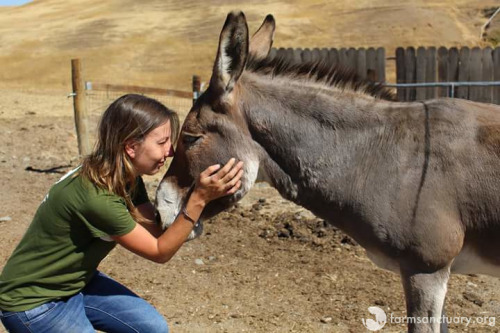
At Farm Sanctuary’s Northern California Shelter with Sierra donkey
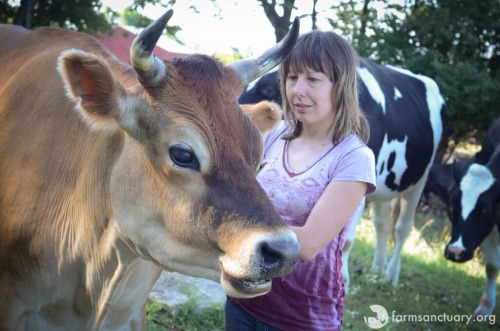
With Dennis steer, whom we rescued from a case last fall where an individual was illegally slaughtering and selling meat raised on his property in Hudson Valley, NY.
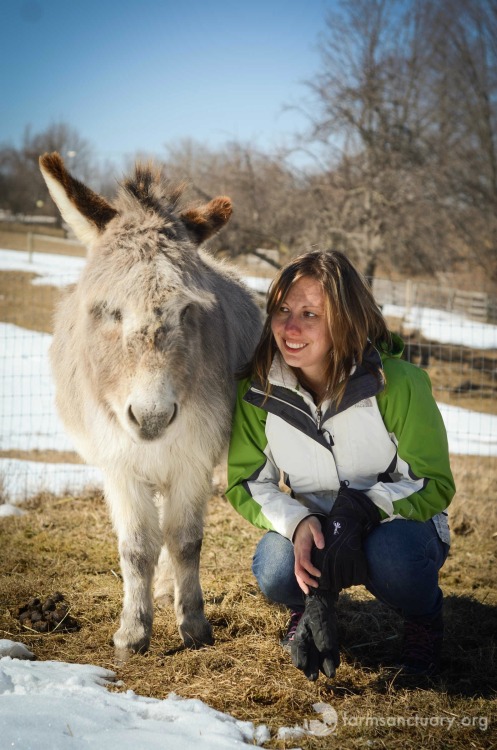
With Colin of Farm Sanctuary’s New York miniature donkey herd.
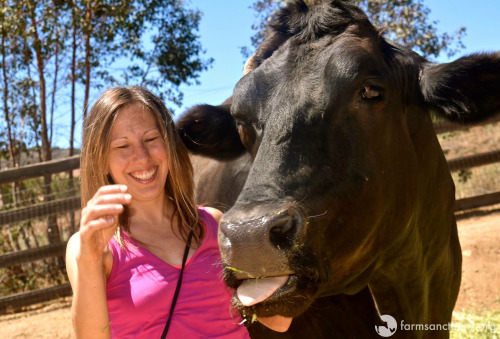
Sloppy kisses from Bruno steer at Farm Sanctuary’s Souther California Shelter
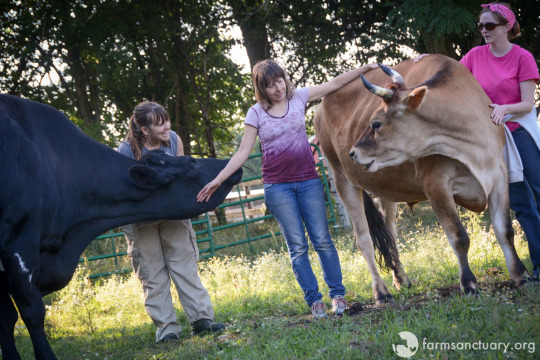
From left to right: Moo, Farm Sanctuary National Shelter Director Susie Coston, Lindsay, Dennis, and Farm Sanctuary Editor Lindsay Barnett
While Lindsay’s activism comes from an ethical standpoint these days, her journey began with a general distaste for meat – a disturbance caused by intimate knowledge about where her meat was really
coming from. “I had the fortune of having a grandfather in the meat brokerage business, so I knew a lot more that most kids about that journey from ‘farm’ to table,” Lindsay says. “He proudly displayed posters of cuts of beef. And I stopped eating that meat in high school, when I really started to think about where his supply chain started. Back then it was simple in my mind: I didn’t want to eat cows.”
Around this time, knowledge about the negative health effects of consuming red meat was reaching the mainstream. This inspired Lindsay’s family to alter the meals they ate, in favor of what they thought to be healthier options. “We’d eat more fish, chicken, pastas, garden-fresh veggies, and substitute the butter with
olive oil,” Lindsay recalls. “We’d substitute eggs with Egg Beaters. And we ate a lot less dairy.” For Lindsay, it was easy draw the line at “red meat,” largely in part because it was socially acceptable to do so. And while she felt uncomfortable knowing that this meat came from now-deceased cattle, she lacked the personal connections with other farm animals to recognize that there were no inherent differences between the animals she chose to eat versus eschew.
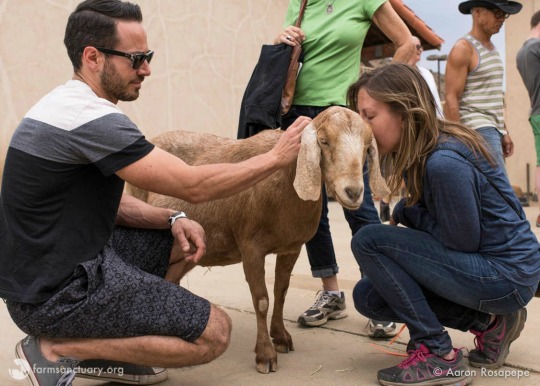
Upon meeting ambassadors including Maria, Lindsay’s brother Erik (pictured) actually went vegan last year.
Until one fateful day in Lindsay’s senior year of high school, when she was forced to confront the disturbing reality that had once felt more convenient to overlook. It was time to study the inner workings of an animal through dissection – an exercise that many schools tout as a practical, efficient way to learn about
the body. But Lindsay walked away with a different kind of understanding.
“Our professor pulled frozen cats out of plastic bags from a cooler and placed each on our lab table,” Lindsay recalls. “And I set about performing an autopsy on this poor creature, who looked like she’d died in that bag. That cat haunted me. It wasn’t just the fact she still had whiskers and fur; when I opened her
up, I saw her white flesh. And I couldn’t help but draw the comparison to chicken.
“Later that night, sure enough, chicken was on Mom’s dinner menu. And I swear I started smelling formaldehyde. The sensory memories were just too much. I wouldn’t eat chicken that night.” Shortly thereafter, Lindsay swore off eating chickens – and the flesh of other beings. “A few months later, I was getting off a bus at McDonald’s with teammates after competing in a swim meet. I ordered my usual
grilled chicken salad without thinking. And they forgot to cook the chicken. It was still frozen when it hit my mouth. And I of course thought of that poor cat I’d dissected. I threw out my salad.”
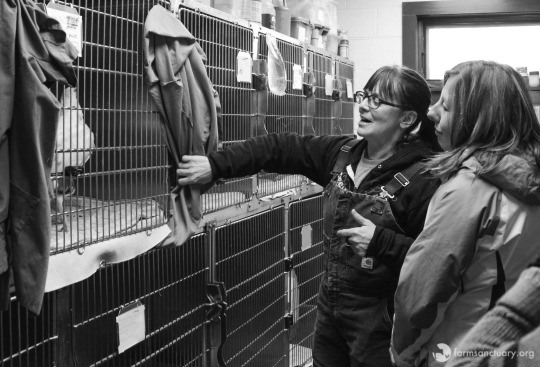
Learning from Susie about chickens raised for meat and eggs.
By the time she started college, Lindsay was introducing herself as a vegetarian who didn’t eat eggs or most dairy. But growing up in Wisconsin, “America’s Dairyland,” it was considered blasphemy to give up milk entirely. “So I’d only drink skim milk,” Lindsay says, “until I very suddenly began to experience swelling of my throat, and was diagnosed as allergic.
“I was an accidental vegan, who knew barely anything about the animals, except for cattle raised for beef. But I wasn’t the only one. I once told a classmate I didn’t eat animals, because I didn’t like the idea of eating cows, pigs, fish, and birds. And she laughed, ‘Pigs?! Who eats pigs?’ It’s so easy to forget the farm-to-table connection. It seems my friend had, until that moment, pushed what was out of sight, far out of mind. And I had no idea she’d harbored such blissful ignorance for so long.”
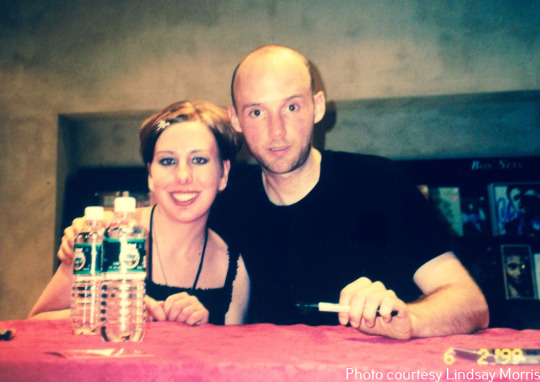
Lindsay at age 20 with Moby, a vegan idol and favorite musician.
This was a crucial turning point for Lindsay who, for the first time, started to analyze the disconnect that people experience regarding where their food comes from. While Lindsay considered veganism to be a diet – and not a lifestyle – at this point in time, she started to see things about society’s relationships with
animals that had once been so convenient to push aside.
Lindsay still had her own battles acknowledging what she knew to be true, however. A few years ago, she was taking a culinary class when she made the decision to sample a bite of a meal she had cooked – a meal that was not vegetarian. But while veganism, until that point, had been more about herself – a response to
her distaste for meat and her body’s own rejection of dairy products – Lindsay would soon come to realize that the decisions she made extended far beyond herself. Recognizing that the choice she made felt wrong, she started reading Jonathan Safran Foer’s book, Eating Animals.
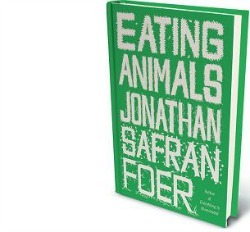
Author Jonathan Safran Foer cites Farm Sanctuary as the first place he went to begin research for his book.
“It hurts to know the truth,” says Lindsay. “To read the tale of a pig nuzzling his would-be executioner or the chicken that sees the sun for the first, last time, having survived two years in a file-box-sized cage stuffed with feathered friends and foes.
“I know these conversations are challenging. But it’s critical we know where our food comes from; what sacrifices were made to bring farm to table; what that so-called farm really is; and our collective role
as consumers and bystanders.”
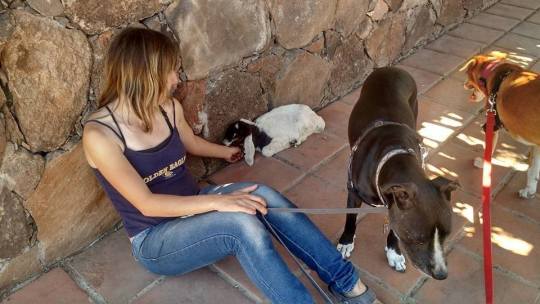
“I see these animals as no different than my own companion dogs, Sadie and Winston,” says Lindsay, here with a baby goat in Mexico.
Lindsay’s experiences are not uncommon; they demonstrate that there is no right or wrong way to embark on our compassionate journeys – what does matter is an attempt to do our very best with what we have, and where we are. We make a difference every time we align our actions with our values. Forced to face her own involvement in animals’ suffering, Lindsay recognized that the innocent bite she sampled in class was not so innocuous after all. And her choice to examine what she knew contradicted her values eventually led her to make decisions that she could feel good about – and even changed her outlook on what her relationship with farm animals truly entailed.
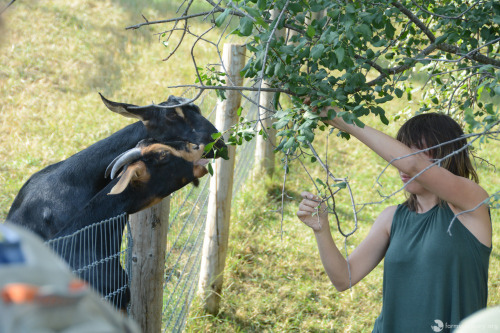
Extending a branch to Olive and her daughter Maggie.
After a
15-year career in journalism and corporate media, Lindsay knew she needed to embark on a different kind
of path – a position in which she could use her craft to promote awareness and push for change. So she applied for a position at Farm Sanctuary – a decision that not only agreed with her compassionate values, but opened the door for more fulfilling connections and realizations than she had ever thought
possible.
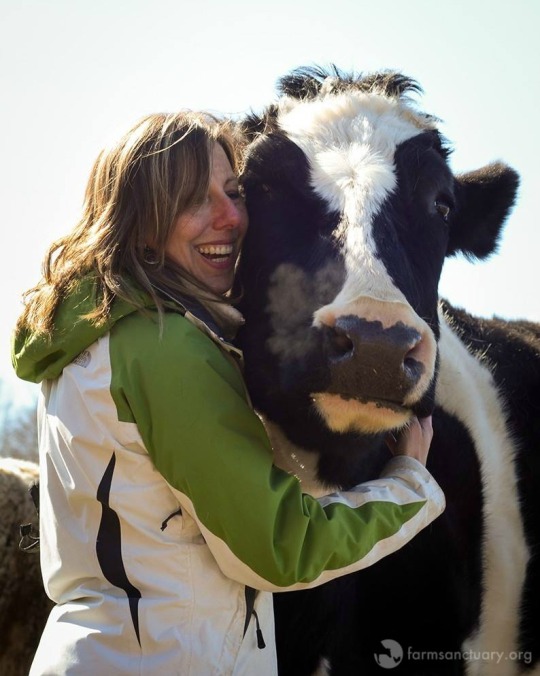
From America’s Dairyland to Farm Sanctuary life: Meeting Faith cow
“I wanted this job because I do believe change can happen. I want us to shine light on abuse and apathy. And it’s time for me to consider how to help other plant-based eaters and veg-curious learn how to live in alignment with their values. It’s also critical to know your facts, so that you can have informed dialogue with the omnivore on the other side of the table. There is so much information that needs to be shared; so many stories that need to be heard; so many pictures that need to be seen.”
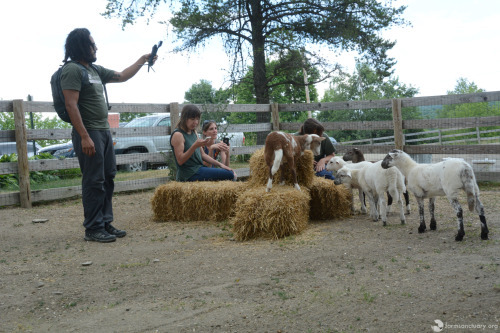
Behind the scenes with the Cattaraugus lambs: Lindsay (center) with staffers Email Marketing Specialist Jae Ramos (left) and Visual Communications Coordinator Chrissy Wahlstrom.
In her current position, Lindsay oversees a team of compassionate individuals looking to shed light on the atrocities committed against farm animals each day – and to empower people by sharing how easy it can be to make concrete steps towards creating a more compassionate world for all. Many of these connections come about by inspiring people to get to know our rescued residents on an individual level – to see that each being is someone, not something, and therefore worthy of our love and protection. Getting to know
our rescued residents up close actually broadened Lindsay’s veganism from a dietary to an ethical choice; and now, she applies her time and talents towards speaking up for these individuals who cannot speak for themselves – and she encourages others to shift the dialogue about the ways in which society views
and treats farm animals everywhere.
“I’d never visited Farm Sanctuary until after I was employee. The first time was to oversee a volunteer work party at our Southern California Shelter with Livestrong.com. We pulled weeds for about two hours that seemed like nothing, because we were being watched and teased by Yoda llama and the late Prince goat.
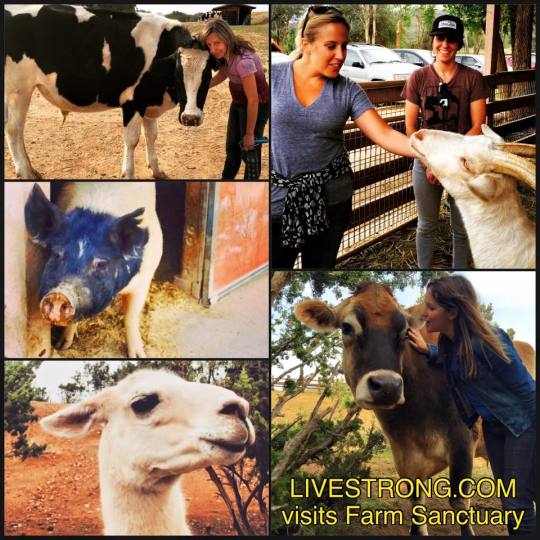
“Afterward, we visited the cattle. I grew up in Wisconsin, America’s Dairyland; my grandfather interfaced with cattle ranchers across the country. I’d seen my fair share of cattle on roadsides and grazing in fields. And yet, I’d never once touched a cow, or a steer like Safran, Pinto, Bruno, or Paolo.
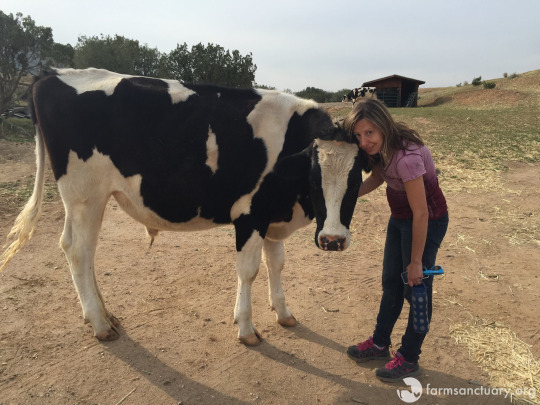
From reading Jonathan Safran Foer to visiting Safran steer.
“Paolo truly fascinated me; he has these Disney Princess-like saucer eyes and long lashes. I’d never imagined cattle could be so beautiful. He was more aloof than the others, but he let me approach. He was so soft and he had such calm energy. I whispered, ‘Good boy,’ in his ear, and he turned and neck hugged me. My heart
felt like it was going to explode and my mind was racing, I looked at Paolo and his friends and realized that I’d had it wrong. Veganism wasn’t about me. The food choices had brought me on this journey, but meeting these animals made me realize I had so much farther to walk.”

Receiving a neck hug from Paolo at Farm Sanctuary’s Southern California Shelter.
Today, Lindsay’s primary motivator is to demonstrate the rich emotional lives of beings just like Paolo. Since that fateful meeting, she has striven to live as compassionately as possible – the day she met Paolo, for example, Lindsay donated all of her leather items to a local thrift shop that benefited animal charities. She also switched her dogs to a vegan diet as well – and they not only love their new food, but are much fitter and healthier than ever. Still, Lindsay acknowledges that living compassionately is a process – a journey, not a destination. “We all started this journey in our own way,” Lindsay explains. “This week I celebrate 20 years vegetarian, but I am still a newbie – crawling and learning with each experience. And I’ve already had so many thanks to Farm Sanctuary.
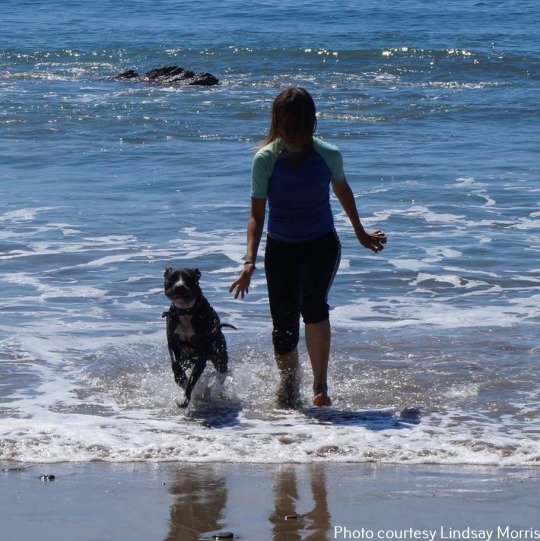
An afternoon of body-surfing with Sadie dog at Leo Carrillo Beach in Malibu, CA.
“Once you start to empathize with animals, your whole world changes. Even the hunter cannot ignore that an animal has run, hidden, and fought to preserve her life. But I cannot judge that hunter; he is more aware than most people of where his food comes from. Still, while I can’t judge, I can stand firmly in my own
position, and now more than ever. All animals have a will to live, and I cannot personally justify being a part of denying that.”
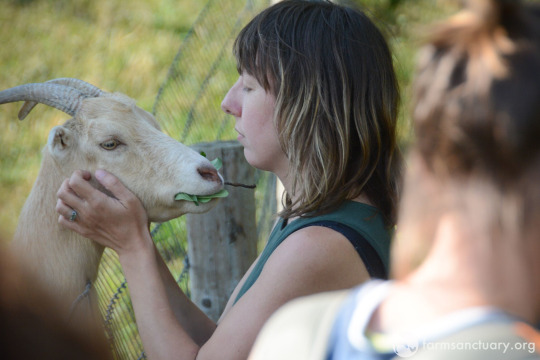
With Tatiana, whom we rescued last year from a Hudson Valley backyard-butcher operation.
With Lindsay’s support, we are effectively communicating compassionate values to more and more individuals, changing hearts and minds about our relationships with farm animals everywhere. Lindsay’s journey is inspiring because it is realistic and familiar – like Lindsay, many of us have adopted a more
compassionate lifestyle in fits and spurts, adjusting our values overtime to reflect the choices that we make. We are thankful that Lindsay has chosen to pay it forward in her current role and as she helps disseminate information about both the horrors of modern animal agriculture and the beautiful difference that compassion makes, we are grateful for her leadership as we continue upon this compassionate journey together.
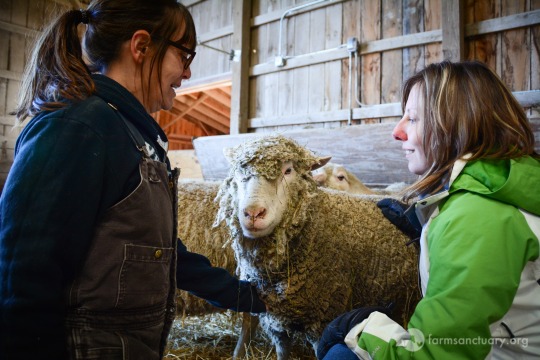
Susie shows Lindsay where Grace loves to be scratched.
Enviroshop is maintained by dedicated NetSys Interactive Inc. owners & employees who generously contribute their time to maintenance & editing, web design, custom programming, & website hosting for Enviroshop.

That is one of the greatest things. I also adore all the pictures.